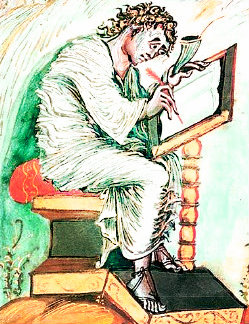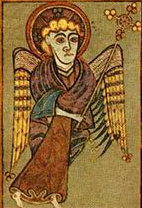100 Greatest Painters Artists Alphabetically Artists by Country Artists by Century Artists by Movement
The Monastic Scriptorium
517 - 1250

In the earlier Middle Ages, books were generally handwritten and painted in monastic scriptorium. The scriptorium was looked upon as a sort of sanctified dwelling, and the craft of reproducing and embellishing manuscipts was considered a labour of religious dedication and devotion?entered upon with heartfelt prayer, and only approved by the superior, especially when the books to be written was a Bible. The monastic scribes worked in strictly enforced silence with candles being forbidden lest the precious works accidentally catch fire. The scriptorium was a place for the copying and writing of books. It was generally a large room adjacent to a monastery. Historian F. Somner Merryweather describes the working conditions "In most monasteries there were two kinds of Scriptoria, or writing offices; for in addition to the large and general apartment used for the transcription of church books and manuscripts for the library, there were also several smaller ones occupied by the superiors and the more learned members of the community, as closets for private devotion and study. Thus we read, that in the Cistercian orders there were places set apart for the transcription of books called Scriptoria, or cells assigned to the scribes, "separate from each other," where the books might be transcribed in the strictest silence, according to the holy rules of their founders. These little cells were usually situated in the most retired part of the monastery, and were probably incapable of accommodating more than one or two persons; dull and comfortless places, no doubt, yet they were deemed great luxuries, and the use of them only granted to such as became distinguished for their piety, or erudition."
Monks were regularly commissioned by royalty and members of the Church. They copied the Sacred Scripture and the writings of early Church Fathers. According to Medieval historian, Julia De Wolf Addison, "It was often with a sense of relief that a monk finished his work upon a volume, as the final word, written by the scribe himself, and known as the Explicit, frequently shows. In an old manuscript in the Monastery of St. Aignan the writer has thus expressed his emotions: "Look out for your fingers! Do not put them on my writing! You do not know what it is to write! It cramps your back, it obscures your eyes, it breaks your sides and stomach!" It is interesting to note the various forms which these final words of the scribes took; sometimes the Explicit is a pathetic appeal for remembrance in the prayers of the reader, and sometimes it contains a note of warning. In a manuscript of St. Augustine now at Oxford, there is written: "This book belongs to St. Mary's of Robert's Bridge; whoever shall steal it or in any way alienate it from this house, or mutilate Page 355 it, let him be Anathema Marantha!" A later owner, evidently to justify himself, has added, "I, John, Bishop of Exeter, know not where this aforesaid house is, nor did I steal this book, but acquired it in a lawful way!""
With the triumph of Christianity, the early illuminators aspired to reawaken the divine spirit of holy figures rather than depict their physical qualities. Their unique style is a combination of frontal simplicity, truth to nature, harmonious unity together with precision in details. Supplies were extremely costly, and included ground up precious stones and gold and silver leaf. The labour involved was tremendous and illustrated manuscripts often took years and sometimes decades to complete. Only the rich and powerful could afford to purchase such masterpieces. Most members of royal families had a collection of specially commissioned books. Illuminated books were status symbols and considered to be as precious as gold.

☼☼☼☼☼
Important Words, People, Phrases, Characteristics related to the Italian Renaissance Art Movement - rebirth, rediscovery of the classical world, City-state, Humanism, Humanist, Francesco Petrarch, Reform, The Prince, Theocracy, The Inquisition, Human Reasoning, Medici Academy, publication of Della Pittura, a book about the laws of mathematical perspective for artists, sfumato, chiaroscuro, linear perspective, Heliocentric Theory, Petrarch, Baldassare Castiglione, The Book of the Courtier, liberal arts, civic humanism, Verrocchio, secularism, Leonardo Bruni, Lorenzo Valla, Neo-Platonism, nominalism, Giotto, Masaccio, Botticelli, Quattrocento, vanishing point, Savonarola, oligarchy spiritually significant, illuminated manuscript, idealized biblical themes, scriptorium, emotion, illuminator, iconoclast, Michelangelo and Leonardo Da Vinci, Age of Discovery, axonometric drawing, curiosity about the natural world, mythology, realistic use of colours and light, Bonfire of the Vanities, Old Testament stories, ethereal and foggy backgrounds, Gospel parables, The Blackdeath, romanticized landscapes, Christian symbolism. Paradise
Search for Artists by Century Important Painters Born in the 13th Century Important Painters Born in the 14th Century Important Painters Born in the 15th Century Important Painters Born in the 16th Century Important Painters Born in the 17th Century Important Painters Born in the 18th Century Important Painters Born in the 19th Century☼☼☼☼☼
If you feel you have worthwhile information you would like to contribute we would love to hear from you. We collect essential biographical information and artist quotes from folks all over the globe and appreciate your participation. When submitting please, if possible, site the source and provide English translation. Email to historyofpainter@gmail.com
|
|
|
|
|
© HistoryofPainters.com 2017
If you like this page and wish to share it, you are welcome to link to it, with our thanks.
Milanese School,
Ferrara School
Sienese School
Florentine School
Venetian School
Early Renaissance
High Renaissance
Northern Renaissance
Popular Questions About Renaissance Art History
What is the difference between Italian Renaissance art and Northern Renaissance art?
How did the Black Death impact European art history?
How did the Inquisition impact European art history?
What was the influence of the Medici Academy on Renaissance painters?
What was the Bonfire of the Vanities?
Who were the greatest painters of the Renaissance?